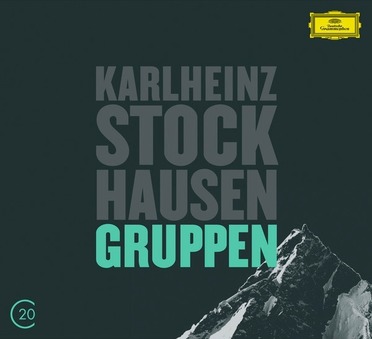










On the last page of the published score of Gruppen (Groups), Stockhausen entered: Deo gratias. Paspels bei Chur 1955, Köln 1957. Like Stravinsky s Rite of Spring, Stockhausen s work was conceived in an Alpine landscape. The Rite was composed at Clarens, overlooking Lake Geneva and the French Alps, while Gruppen was planned and partly written in the Eastern Swiss Alps of Graubünden. In his programme note for the premiere, Stockhausen wrote that Gruppen marked a new phase in his development of the spatial deployment of instrumental music . He achieved this by using three independent orchestras, each with its own conductor. For most of the time they play as separate entities, at different speeds, but occasionally these coincide they meet in a common audible rhythm , as Stockhausen put it. The orchestras interact in other ways too: calling and answering, or echoing phrases from one of the other orchestras. Stockhausen uses a range of other spatial devices as well: For a while only music from the left, from the front or from the right may be heard; [or] the sound may transmigrate from one orchestra to another.
At the same time as working on Gruppen, Stockhausen was also experimenting with ways of using the spatial placement of electronic sounds through loudspeakers in Gesang der Jünglinge (1955 56). Gruppen represents the application of a similar approach to live orchestral writing. In his programme note, Stockhausen wrote that spatial deployment now becomes functional. (It is difficult to mount such music in existing concert halls.) Each sound-source is now in a position to make its own temporal measures felt, and the listener finds himself in the middle of several temporal measures which combine to create a further common time-world. Furthermore, the sources no longer produce points of sound ... but rather they produce groups : groups of sounds, of noises and of combined sound and noise, each an autonomous unit. At several places in the score, the three orchestras seem to be moving closer together, playing at the same speed, with the same harmonies and orchestration. In the score at these places, Stockhausen says the orchestras become transformed: one receives the other into itself. Or plays with it. Extinguishes it. They fall apart or cling together. But these moments never become permanent. For Stockhausen, the three orchestras can never entirely coalesce, as they still remain spatially separate.
The first performance of Gruppen was given in Cologne s Rheinsaal a large exhibition hall more usually used for trade fairs. It took place on 24 March 1958, with the Cologne Radio Symphony Orchestra conducted by Bruno Maderna, Pierre Boulez and Stockhausen himself. The present live recording was made in the music in the round acoustical environment of the Berlin Philharmonie.
Among early reactions to the piece, one is of particular interest. In Memories and Commentaries, Robert Craft asked Stravinsky: What piece of new music has most interested you in the last year? The composer s reply was:
Stockhausen s Gruppen. The title is exact: the music really does consist of groups, and each group is admirably composed according to its plan of volume, instrumentation, rhythmic patterns, tessitura, dynamic, various kinds of highs and lows ... The question of the three orchestras has aroused much comment. Actually when the orchestras play separately or overlap, their roles are very marked, but in the tutti sections they simply sound like one orchestra, and this is true of all poly-orchestral music whether it is by Schütz or Mozart or Charles Ives, or anyone else.
Stravinsky praised the remarkable sounds of the orchestration, and bestowed on it the ultimate Stravinskian compliment: The rhythmic construction of Gruppen is, I think, of the greates
| Track | Duration |
|---|---|
| Grabstein fur Stephan | 9:31 |
| Gruppen | 22:34 |
| I Adagio attacca | 2:31 |
| II Lamentoso disperato, con moto | 4:07 |
| III Molto sostenuto | 5:55 |

